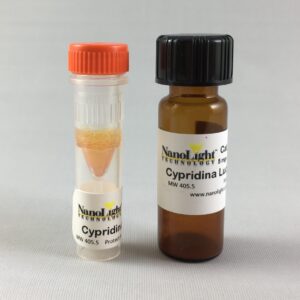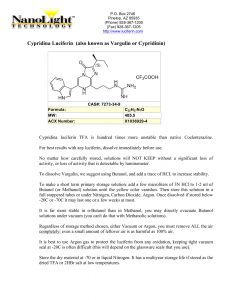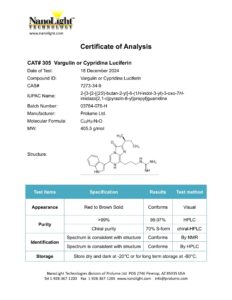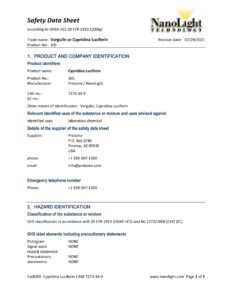
also known as Vargula Luciferin or Vargulin,
enantiomeric mixture: 70% S-form, 30% R-form
both forms are luminous active
- Details & Info
- Protocols & Data
- Publications

Compound ID Vargulin or Cypridina Luciferin Molecular Formula C22H27N7O IUPAC Name 2-[3-[2-[(2S)-butan-2-yl]-6-(1H-indol-3-yl)-3-oxo-7H-imidazo [2, 1-c]pyrazin-8-yl]propyl]guanidine MW 405.5 g/mol Cypridina was first characterized by Dr Osamu and Akemi Shimomura from “Umi Hotaru” Japanese Sea Fireflies in 1966. These are bottom dwelling ostracods that emit a light stream into water when disturbed presumably to deter predation. Cypridina Luciferase was first cloned by Eric Thompson, and S. Nagata under Fred Tsuji in Japan 1989. Cypridina is a 555 amino acid, 62.171 KDa protein that oxidizes the luciferin to produce blue light at 462 nm Em Max. The advantage of using the Cypridna system: it does not cross react with Coelenterazine or Firefly d-Luciferin so it may be used in multiplex assays. It is brighter then Firefly Luciferase.
Natural occurring Cypridina Luciferin is 100% S-form. NanoLights Cypridina synthesized compound is an enantiomeric mixture of 70% S and 30% R form. The recently published paper describes that the R-form is also a luminous substrate for Cypridina Luciferase with a 3-fold lower turnover rate and not a competitive inhibitor as previously thought. Therefore, a negative impact on Cypridina bioluminescent assays is not expected.
We would like to thank the authors for the detailed analysis of our product.
Kanie S, Wu C, Kihira K, Yasuno R, Mitani Y, Ohmiya Y. Bioluminescence of (R)-Cypridina Luciferin with Cypridina Luciferase. Int J Mol Sci. 2024 Feb 26;25(5):2699.
Inouye S. Pink-colored Cypridina luciferase from Cypridina (Vargula) hilgendorfii: Oxygen-triggered luminescence reaction following NAD(P)H-FMN flavin reductase reaction. Biochem Biophys Res Commun. 2025 Feb 2;747:151285.
The advantages of lyophilized luciferins are:
- pre-aliquoted in small amounts, fresh substrate for every set of experiments
- long shelf-life (packed under Argon)
- faster to dissolve due to its fine crystal structure
- consistent quality between aliquotes
The luciferin is shipped as filtered, lyophilized, batch controlled substrate
Suggested Articles
PMID 39798538 (view abstract) Author Inouye S Date 2025 Feb 2 Journal Biochemical and biophysical research communications PMID 38473946 (view abstract) Author Ohmiya Y Date 2024 Feb 26 Journal International journal of molecular sciences








